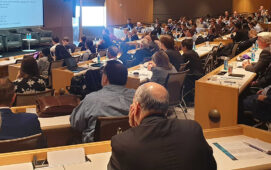
The Fixed Income Clearing Corporation (FICC), a subsidiary of the Depository Trust and Clearing Corporation (DTCC), has launched two new publicly available tools to help participants navigate the financial obligations that come with membership in a clearing system.
The facilities are aimed at helping firms address the post-trade implications of a Securities and Exchange Commission (SEC) July 2023 rulemaking that mandated central clearing for a wide range of U.S. Treasury (UST) securities transactions including cash, repurchase agreements (repos) and reverse repos.
This new rule will have a significant impact on UST post-trade operations for all participants that currently clear and settle their trades on a bilateral basis. These participants will now have to find an appropriate way to connect with a central clearing system and make the necessary changes in their clearing and settlement technology.The UST market sees daily transactions averaging over $700 billion in cash and $4.5 trillion in financing, making it vital for U.S. government funding, monetary policy, and as a safe haven for global investors. The market has grown rapidly and disproportionately where currently, 87% of this trading activity is cleared bilaterally.
Several liquidity events over the past decade highlighted vulnerabilities in the treasury market where the systemic risk of a non-participant failing required mitigating. The SEC’s final rule, adopted in December 2023, aims to expand central clearing to mitigate such counterparty and systemic risks.
The new rule seeks to transition a substantial portion of the daily US $4.9 trillion treasury market activity to central clearing through a central counterparty (CCP). Currently, the only authorised CCP for the UST market is FICC. However, other CCPs have expressed interest, among them London Clearing House (LCH).
Tools of the Trade
The first of the new FICC tools, a Capped Contingency Liquidity Facility (CCLF) Calculator, is designed to increase the transparency into the financial obligations associated with membership in the FICC Government Securities Division (GSD).
The CCLF is a critical risk management facility designed to provide FICC with additional liquidity resources to meet cash settlement obligations in the event of a default by the largest netting members (see DTCC Risk Management Tools). By allowing firms to estimate their potential CCLF obligations, the calculator aids in better liquidity planning and risk management. This can make FICC membership more attractive and manageable for a broader range of market participants, including smaller institutions and buy-side firms.
The calculator helps firms anticipate and plan for the liquidity commitments required under the new SEC clearing mandates. By providing upfront attestations regarding their ability to meet CCLF obligations, firms can ensure they are prepared to comply with the expanded central clearing requirements for U.S. Treasury securities.
The second is a Value at Risk (VaR) calculator from DTCC to help market participants evaluate potential margin and clearing fund obligations associated with joining GSD. With U.S. Treasury Clearing activity through FICC projected to increase by US$4 trillion daily following the expanded clearing mandate in 2025 and 2026, the VaR calculator will be essential for firms to accurately determine their VaR and margin obligations for simulated portfolios.Tim Hulse, Managing Director of Financial Risk & Governance at DTCC, emphasized that VaR is a key risk management concept and a primary component of GSD’s Clearing Fund requirements. The calculator uses historical data, volatility, and confidence levels to estimate VaR, thus enhancing market transparency. It allows market participants to calculate potential margin obligations for given positions and market values using FICC’s VaR methodology.
Hulse highlighted the urgency of evaluating firms’ risk exposure with the expansion of U.S. Treasury Clearing, noting that the VaR calculator offers increased transparency into these obligations.
These tools are public and not restricted to member firms This means that as firms consider their optimal approach to access central clearing for compliance with the the new clearing rules, these risk tools can provide the necessary transparency and support as firms evaluate the different types of membership and models with GSD.
The SEC has introduced several measures to make FICC access more inclusive. FICC offers multiple membership models, including Netting Membership, Agented Clearing, Sponsored Membership, and Centrally Cleared Institutional Triparty (CCIT) Membership, catering to a wide range of market participants from large banks to hedge funds. The SEC has provided temporary regulatory relief to address custody and diversification concerns for registered funds.
CCIT membership primarily benefits institutional cash lenders such as corporations, asset managers, insurance companies, sovereign wealth funds, pension funds, municipalities, and State treasuries. It allows these entities to engage in tri-party repo transactions with enhanced risk management and operational efficiency provided by FICC. The central clearing of these transactions helps reduce counterparty risk, ensure the completion of trades, and potentially offer balance sheet netting and capital relief for participants.
The Securities Industry and Financial Markets Association (SIFMA) is actively coordinating multiple work streams that involve both buy-side and sell-side members. These efforts aim to accelerate the necessary transitions for the clearing mandates. Key aspects include engaging with the SEC and other regulatory agencies to address market access issues, particularly for registered funds and margin transfers, which are crucial for ensuring a smooth transition to central clearing.
Developing an operations timeline with key milestones is another critical task. This timeline will guide the transition to full central clearing by June 2026 for repos. Addressing issues related to market plumbing and connectivity is also vital to support the increase from 13% to 100% clearing. This involves ensuring that all participants can effectively connect to and use the central clearing infrastructure.
Regular communication with market participants is planned to keep them informed about progress and strategies for meeting the clearing deadlines. This will include updates on the status of various strategies and the overall progress towards the deadlines. SIFMA will also engage in regular discussions with the SEC and other agencies to ensure they are aware of the progress and any potential needs for timeline adjustments or phased rollouts.
Legal and enforceability issues will be addressed by obtaining netting enforceability opinions in relevant jurisdictions to support large-scale clearing. This step is closely tied to the development of market standard documentation. Additionally, new documentation approaches that leverage modern communication methods will be evaluated to increase efficiency.
Stakeholder engagement is essential to confirm the status of various strategies and ensure alignment with the clearing deadlines. SIFMA plans to reach out to market participants regularly to keep them informed and engaged. This will help ensure that all participants are on track to meet the clearing mandates.
Lastly, future planning includes preparing for additional publications and podcasts to keep the membership and broader public informed about ongoing efforts around Treasury clearing. This will ensure that everyone remains updated on the progress and any developments related to the central clearing mandate.
Subscribe to our newsletter



